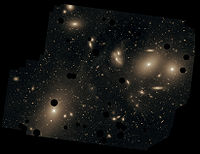
Hot Dust in Ultraluminous Infrared Galaxies
Sign Up to like & getrecommendations! Published in 2017 at "Astrophysics"
DOI: 10.1007/s10511-017-9498-1
Abstract: Ultraluminous infrared galaxies with total luminosities an order of magnitude greater than that of our galaxy over wavelengths of λλ = 10-800 μm are characterized by a high mass concentration of dust. Because of this,… read more here.
Keywords: galaxy; interstellar gas; dust; infrared galaxies ... See more keywords

Optical detection of a GMRT-detected candidate high-redshift radio galaxy with 3.6-m Devasthal optical telescope
Sign Up to like & getrecommendations! Published in 2019 at "Journal of Astrophysics and Astronomy"
DOI: 10.1007/s12036-019-9583-4
Abstract: We report optical observations of TGSS J1054+5832, a candidate high-redshift ($$z=4.8\pm 2$$z=4.8±2) steep-spectrum radio galaxy, in r and i bands, using the faint object spectrograph and camera mounted on 3.6-m Devasthal Optical Telescope (DOT). The… read more here.
Keywords: high redshift; galaxy; radio; telescope ... See more keywords

The remnant radio galaxy associated with NGC 1534
Sign Up to like & getrecommendations! Published in 2019 at "Publications of the Astronomical Society of Australia"
DOI: 10.1017/pasa.2018.26
Abstract: Abstract We present new observations of the large-scale radio emission surrounding the lenticular galaxy NGC 1534 with the Australia Telescope Compact Array and Murchison Widefield Array. We find no significant compact emission from the nucleus… read more here.
Keywords: radio emission; galaxy; radio; ngc 1534 ... See more keywords

Outflows in the Seyfert 2 galaxy NGC 5643 traced by the [S iii] emission
Sign Up to like & getrecommendations! Published in 2018 at "Publications of the Astronomical Society of Australia"
DOI: 10.1017/pasa.2018.31
Abstract: Abstract We use Gemini Multi-Object Spectrograph integral Field Unit observations of the inner 285 × 400 pc2 region of the Seyfert 2 galaxy NGC 5643 to map the [S iii]λ9069 emission line flux distribution and… read more here.
Keywords: galaxy; galaxy ngc; kinematics; seyfert galaxy ... See more keywords

The GLEAMing of the first supermassive black holes: II. A new sample of high-redshift radio galaxy candidates
Sign Up to like & getrecommendations! Published in 2022 at "Publications of the Astronomical Society of Australia"
DOI: 10.1017/pasa.2022.42
Abstract: Abstract While unobscured and radio-quiet active galactic nuclei are regularly being found at redshifts $z > 6$ , their obscured and radio-loud counterparts remain elusive. We build upon our successful pilot study, presenting a new… read more here.
Keywords: galaxy; high redshift; new sample; survey ... See more keywords

The stellar orbit distribution in present-day galaxies inferred from the CALIFA survey
Sign Up to like & getrecommendations! Published in 2017 at "Nature Astronomy"
DOI: 10.1038/s41550-017-0348-1
Abstract: Galaxy formation entails the hierarchical assembly of mass, along with the condensation of baryons and the ensuing, self-regulating star formation1,2. The stars form a collisionless system whose orbit distribution retains dynamical memory that can constrain… read more here.
Keywords: galaxy; orbit distribution; califa survey; present day ... See more keywords

A relation between the characteristic stellar ages of galaxies and their intrinsic shapes
Sign Up to like & getrecommendations! Published in 2018 at "Nature Astronomy"
DOI: 10.1038/s41550-018-0436-x
Abstract: Stellar population and stellar kinematic studies provide unique but complementary insights into how galaxies build-up their stellar mass and angular momentum1–3. A galaxy’s mean stellar age reveals when stars were formed, but provides little constraint… read more here.
Keywords: galaxy; age; stellar population; resolved stellar ... See more keywords

Constraining black hole–galaxy scaling relations and radiative efficiency from galaxy clustering
Sign Up to like & getrecommendations! Published in 2019 at "Nature Astronomy"
DOI: 10.1038/s41550-019-0949-y
Abstract: The masses of supermassive black holes are observed to increase with either the total mass or the mean (random) velocity of the stars in their host galaxies. The origin of these correlations remains elusive due… read more here.
Keywords: galaxy; supermassive black; black holes; black hole ... See more keywords

Gas inflow and outflow in an interacting high-redshift galaxy. The remarkable host environment of GRB 080810 at z = 3.35
Sign Up to like & getrecommendations! Published in 2017 at "Astronomy and Astrophysics"
DOI: 10.1051/0004-6361/201731065
Abstract: We reveal multiple components of an interacting galaxy system at z ≈ 3.35 through a detailed analysis of the exquisite high-resolution Keck/HIRES spectrum of the afterglow of a gamma-ray burst (GRB). Through Voigt-profile fitting of… read more here.
Keywords: grb 080810; galaxy; gas; line sight ... See more keywords

Fossil group origins - IX. Probing the formation of fossil galaxy groups with stellar population gradients of their central galaxies
Sign Up to like & getrecommendations! Published in 2018 at "Astronomy and Astrophysics"
DOI: 10.1051/0004-6361/201832625
Abstract: Fossil groups (FGs) are galaxy aggregates with an extended and luminous X-ray halo, which are dominated by a very massive early-type galaxy and lack of L* objects. FGs are indeed characterized by a large magnitude… read more here.
Keywords: galaxy; fossil; central galaxies; stellar population ... See more keywords

Massive star population of the Virgo Cluster galaxy NGC4535: Discovery of new massive variable candidates with the Hubble Space Telescope
Sign Up to like & getrecommendations! Published in 2018 at "Astronomy and Astrophysics"
DOI: 10.1051/0004-6361/201833290
Abstract: We analyzed the massive star population of the Virgo Cluster galaxy NGC 4535 using archival Hubble Space Telescope Wide Field Planetary Camera 2 images in filters F555W and F814W, equivalent to Johnson V and Kron-Cousins… read more here.
Keywords: population virgo; galaxy; virgo cluster; candidate ... See more keywords